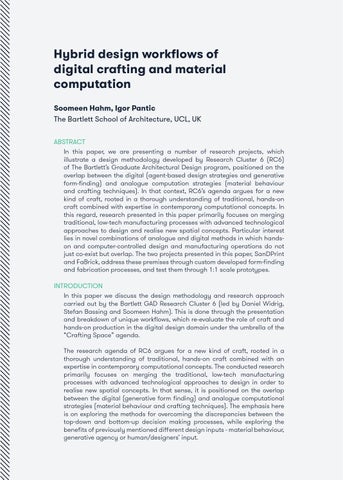Hybrid design workflows of digital crafting and material computation Soomeen Hahm, Igor Pantic The Bartlett School of Architecture, UCL, UK ABSTRACT In this paper, we are presenting a number of research projects, which illustrate a design methodology developed by Research Cluster 6 (RC6) of The Bartlett’s Graduate Architectural Design program, positioned on the overlap between the digital (agent-based design strategies and generative form-finding) and analogue computation strategies (material behaviour and crafting techniques). In that context, RC6’s agenda argues for a new kind of craft, rooted in a thorough understanding of traditional, hands-on craft combined with expertise in contemporary computational concepts. In this regard, research presented in this paper primarily focuses on merging traditional, low-tech manufacturing processes with advanced technological approaches to design and realise new spatial concepts. Particular interest lies in novel combinations of analogue and digital methods in which handson and computer-controlled design and manufacturing operations do not just co-exist but overlap. The two projects presented in this paper, SanDPrint and FaBrick, address these premises through custom developed form-finding and fabrication processes, and test them through 1:1 scale prototypes.
INTRODUCTION In this paper we discuss the design methodology and research approach carried out by the Bartlett GAD Research Cluster 6 (led by Daniel Widrig, Stefan Bassing and Soomeen Hahm). This is done through the presentation and breakdown of unique workflows, which re-evaluate the role of craft and hands-on production in the digital design domain under the umbrella of the “Crafting Space” agenda. The research agenda of RC6 argues for a new kind of craft, rooted in a thorough understanding of traditional, hands-on craft combined with an expertise in contemporary computational concepts. The conducted research primarily focuses on merging the traditional, low-tech manufacturing processes with advanced technological approaches to design in order to realise new spatial concepts. In that sense, it is positioned on the overlap between the digital (generative form finding) and analogue computational strategies (material behaviour and crafting techniques). The emphasis here is on exploring the methods for overcoming the discrepancies between the top-down and bottom-up decision making processes, while exploring the benefits of previously mentioned different design inputs - material behaviour, generative agency or human/designers’ input.
